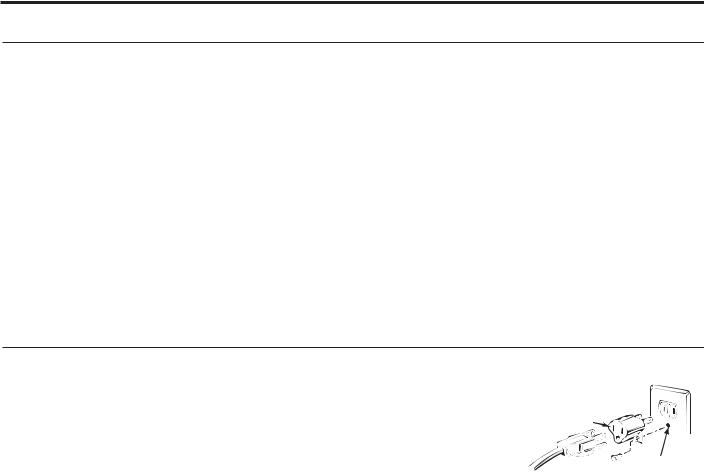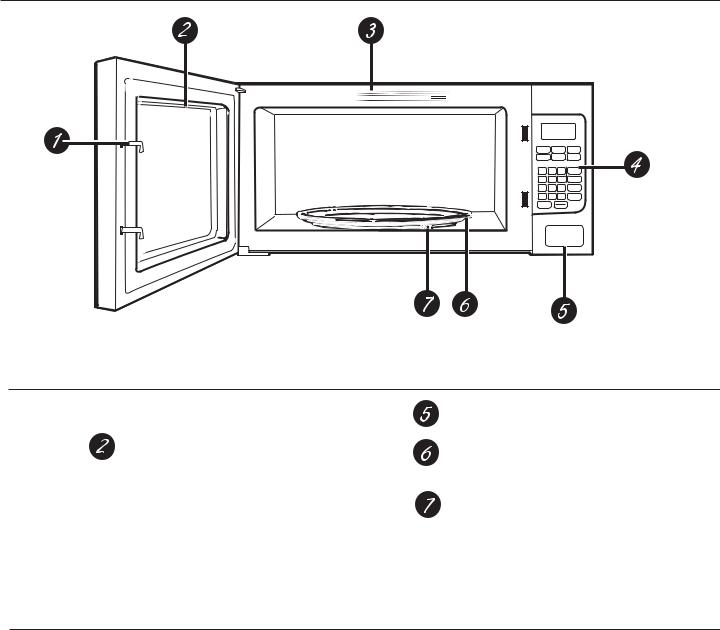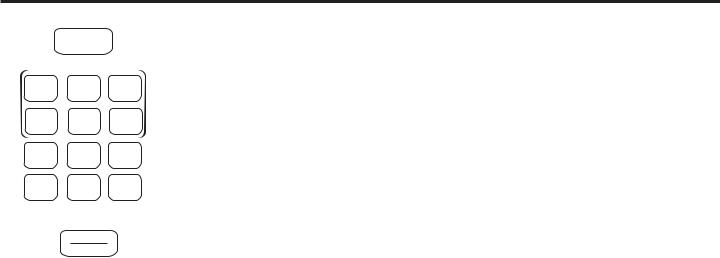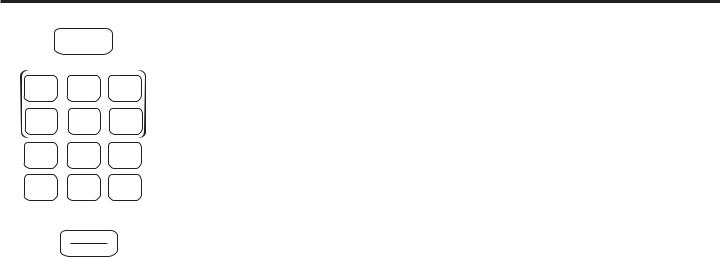GE PEM31DFBB User Manual [en, es]

GEAppliances.com
Microwave Oven
Safety Instructions. . . . . . . .2–8
Operating Instructions
Convenience Features. . . . . . .19-22
Microwave Terms . . . . . . . . . . . . . . 24
Oven Features . . . . . . . . . . . . . .11-13
Other Features . . . . . . . . . . . . . . . . . 23
Power Levels. . . . . . . . . . . . . . . . . . . 13
Time Features. . . . . . . . . . . . . . .16-18
Care and Cleaning . . . . . . . . . 25
Troubleshooting Tips . . . . . . 26 Things that are Normal . . . . . . . . . 26
Consumer Support
Consumer Support. . . . . .Back Cover
Warranty . . . . . . . . . . . . . . . . . . . . . . 27
Write the model and serial numbers here:
Model # __________________
Serial # ___________________
You can find them on a label inside the oven.
Owner’s Manual
PEM31
Español
For a Spanish version of this manual, visit our Website at GEAppliances.com.
Para consultar una version en español de este manual de instrucciones, visite nuestro sitio de internet GEAppliances.com.
49-40699-1 01-14 GE

IMPORTANT SAFETY INSTRUCTIONS.
READ ALL INSTRUCTIONS BEFORE USING.
 WARNING!
WARNING!
For your safety, the information in this manual must be followed to minimize the risk of fire or explosion, electric shock, or to prevent property damage, personal injury, or loss of life.
PRECAUTIONS TO AVOID POSSIBLE EXPOSURE
TO EXCESSIVE MICROWAVE ENERGY
(a)Do Not Attempt to operate this oven with the door open since open-door operation can result in harmful
H[SRVXUH WR PLFURZDYH HQHUJ\ ,W LV LPSRUWDQW QRW WR defeat or tamper with the safety interlocks.
(b)Do Not Place DQ\ REMHFW EHWZHHQ WKH RYHQ IURQW face and the door or allow soil or cleaner residue to accumulate on sealing surfaces.
(c)Do Not Operate the oven if it is damaged. It is particularly important that the oven door close properly and that there is no damage to the:
(1)door (bent),
(2)hinges and latches (broken or loosened),
(3)door seals and sealing surfaces.
(d)The Oven Should Not EH DGMXVWHG RU UHSDLUHG E\ DQ\RQH H[FHSW SURSHUO\ TXDOLILHG VHUYLFH SHUVRQQHO
IMPORTANT SAFETY INSTRUCTIONS.
Use this appliance only for its intended purpose as described in this Owner’s Manual.
When using electrical appliances basic safety precautions should be followed, including the following:
Read and follow the specific precautions in the PRECAUTIONS TO AVOID POSSIBLE EXPOSURE TO EXCESSIVE MICROWAVE ENERGY section above.
This appliance must be grounded. Connect only to a properly grounded outlet. See the GROUNDING INSTRUCTIONS section on page 5.
Install or locate this appliance only in accordance with the provided installation instructions.
Be certain to place the front surface of the door 3" or more back from the countertop edge to avoid accidental tipping of the appliance in normal usage.
This microwave oven is not approved or tested for marine use.
Do not mount this appliance over a sink.
Do not mount the microwave oven over or near any portion of a heating or cooking appliance.
Do not store anything directly on top of the microwave oven surface when the microwave oven is in operation.
Do not operate this appliance if it has a damaged power cord or plug, if it is not working properly, or if it has been damaged or dropped.
Do not cover or block any openings on the appliance.
Use this appliance only for its intended use as described in this manual. Do not use corrosive chemicals or vapors in this appliance. This microwave oven is specifically designed to heat, dry or cook food, and is not intended for laboratory or industrial use.
Do not store this appliance outdoors. Do not use this
SURGXFW QHDU ZDWHU³IRU H[DPSOH LQ D ZHW EDVHPHQW QHDU D swimming pool, near a sink or in similar locations.
Keep power cord away from heated surfaces.
Do not immerse power cord or plug in water.
Do not let power cord hang over edge of table or counter.
To reduce the risk of fire in the oven cavity:
³ 'R QRW RYHUFRRN IRRG &DUHIXOO\ DWWHQG DSSOLDQFH ZKHQ paper, plastic or other combustible materials are placed inside the oven while cooking.
³ 5HPRYH ZLUH WZLVW WLHV DQG PHWDO KDQGOHV IURP SDSHU RU plastic containers before placing them in the oven.
³ 'R QRW XVH WKH RYHQ IRU VWRUDJH SXUSRVHV 'R QRW OHDYH paper products, cooking utensils or food in the oven when not in use.
³ ,I PDWHULDOV LQVLGH WKH RYHQ LJQLWH NHHS WKH RYHQ GRRU FORVHG turn the oven off and disconnect the power cord, or shut
off power at the fuse or circuit breaker panel. If the door is opened, the fire may spread.
See door surface cleaning instructions in the Care and cleaning of the microwave oven section of this manual.
GE does not support any servicing of this microwave oven,
H[FHSW DV GHVFULEHG E\ WKH &RQVXPHU 6XSSRUW VHFWLRQV RI this manual. Do not attempt to service the microwave oven yourself. If service is desired, this appliance should be serviced only by qualified service personnel. Contact the nearest
DXWKRUL]HG VHUYLFH IDFLOLW\ IRU H[DPLQDWLRQ UHSDLU RU DGMXVWPHQW
This appliance must only be serviced by qualified service personnel. Contact the nearest authorized service facility for
H[DPLQDWLRQ UHSDLU RU DGMXVWPHQW
As with any appliance, close supervision is necessary when used by children.
2 |
SAVE THESE INSTRUCTIONS |
|

INSTRUCCIONES IMPORTANTES DE SEGURIDAD. |
|
LEA PRIMERO TODA LAS INSTRUCCIONES. |
GEAppliances.com |
 ¡PRECAUCIÓN!
¡PRECAUCIÓN!
Por su seguridad, la información contenida en este manual debe seguirse para minimizar el riesgo de incendio, explosión, descarga eléctrica, exposición a energía microondas .
PRECAUCIONES PARA EVITAR POSIBLE EXPOSICIÓN A
UNA EXCESIVA ENERGÍA DE MICROONDAS.
(a)No Intente operar este horno con la puerta abierta ya
TXH HVWR SRGUtD UHVXOWDU HQ XQD H[SRVLFLyQ D HQHUJtD microondas dañina. Es importante no cancelar ni manipular de forma indebida los dispositivos de seguridad.
(b)No Sitúe ningún REMHWR HQWUH OD SDUWH IURQWDO GHO KRUQR y la puerta ni permita que se acumule suciedad o residuos limpios en las gomas de cierre hermético.
(c)No Use el horno si está dañado. Es especialmente importante que la puerta del horno se cierre correctamente y que no se dañe:
(1)la puerta (doblada),
(2)bisagras y pasadores (rotos o sueltos),
(3)sellos de la puerta y gomas de cierre hermético.
(d)El horno no debería DMXVWDUVH QL UHSDUDUVH SRU QDGLH que no sea personal de servicio adecuadamente calificado.
INSTRUCCIONES IMPORTANTES DE SEGURIDAD.
Use este electrodoméstico sólo para su propósito original, como se describe en el Manual del Propietario.
Al usar artefactos eléctricos se deberán seguir las precauciones básicas de seguridad, incluyendo lo siguiente:
Lea y obedezca las precauciones específicas en la sección |
0DQWHQJD HO FDEOH GH FRUULHQWH DOHMDGR GH VXSHUILFLHV FDOLHQWHV |
|
de PRECAUCIONES PARA EVITAR POSIBLE EXPOSICIÓN A UNA |
1R SHUPLWD TXH HO FDEOH VH VRVWHQJD VREUH HO H[WUHPR GH OD |
|
ENERGÍA EXCESIVA DE MICROONDAS de arriba. |
mesada. |
|
Este electrodoméstico debe estar conectado a tierra. Conéctelo |
Para reducir el riesgo de incendio en la apertura del horno: |
|
sólo a una toma de corriente con toma de tierra. Vea la sección |
³1R FRFLQH GHPDVLDGR OD FRPLGD 3UHVWH DWHQFLyQ FXLGDGRVD |
|
de INSTRUCCIONES DE TOMA DE TIERRA en la página 9. |
||
al electrodoméstico cuando se coloca papel, plástico u otro |
||
Instale o coloque este electrodoméstico siguiendo sólo las |
||
material combustible en el horno mientras se cocina. |
||
Instrucciones de Instalación provistas. |
³4XLWH ODV FLQWDV GH FLHUUH FRQ PHWDO \ ODV DVDV PHWiOLFDV GH ORV |
|
Asegúrese de colocar la superficie frontal de la puerta 3” o más |
recipientes de papel o plástico antes de introducirlos en el horno. |
|
DWUiV GHO H[WUHPR GH OD EDVH D ILQ GH HYLWDU FDtGDV DFFLGHQWDOHV |
³1R DOPDFHQH FRVDV HQ HO KRUQR 1R GHMH SURGXFWRV GH SDSHO |
|
del electrodoméstico durante un uso normal. |
utensilios de cocinar ni comida en el horno mientras no lo esté |
|
Este horno microondas no está aprobado ni evaluado para uso |
usando. |
|
naval. |
³6L VH LQFHQGLDUD DOJ~Q PDWHULDO GHQWUR PDQWHQJD OD SXHUWD |
|
No monte el electrodoméstico sobre un lavabo. |
del horno cerrada, apague el horno y desconecte el cable de |
|
corriente eléctrica, o apague la corriente en el fusible o panel del |
||
No monte el microondas o cerca de ninguna porción de una |
||
GLIHUHQFLDO 6L VH DEUH OD SXHUWD HO IXHJR SRGUtD H[SDQGLUVH |
||
calefacción o cocina de la aplicación. |
||
Lea las instrucciones de limpieza de la superficie de la puerta en |
||
No guarde nada directamente sobre la superficie del horno |
||
la sección de Cuidado y limpieza del horno microondas de este |
||
microondas cuando el mismo se encuentre funcionando. |
||
No usar este electrodoméstico si el cable de corriente o el |
manual. |
|
GE no respalda ningún servicio técnico sobre este horno |
||
enchufe han sufrido algún daño, si no funciona correctamente |
||
o si ha resultado dañado o se ha caído. |
PLFURRQGDV H[FHSWR FRPR VH GHVFULEH HQ ODV VHFFLRQHV GH |
|
No bloquee ni cubra cualquier abertura del electrodoméstico. |
Soporte al Consumidor de este manual. No intente reparar |
|
el horno microondas usted mismo. Si es necesario reparar el |
||
Dé a este electrodoméstico el uso para el cual fue |
||
electrodoméstico, entonces el servicio deberá ser realizado por |
||
diseñado únicamente, como se describe en este manual. |
||
una persona calificada del servicio técnico. Comuníquese a una |
||
No use productos químicos corrosivos ni vapores en este |
||
sucursal autorizada del servicio técnico para realizar cualquier |
||
electrodoméstico. Este horno microondas fue diseñado |
||
FRQWURO UHSDUDFLyQ R DMXVWH |
||
específicamente para calentar, secar o cocinar comida, y no |
||
Sólo personal cualificado debe reparar este aparato. Póngase en |
||
para uso industrial o en laboratorio. |
||
contacto con el centro de mantenimiento autorizado más cercano |
||
1R XVH HVWH SURGXFWR FHUFD GHO DJXD SRU HMHPSOR HQ XQ |
||
HQ FDVR GH QHFHVLWDU UHYLVLyQ UHSDUDFLyQ R DMXVWH |
||
sótano húmedo, cerca de una piscina, cerca de un lavabo o en |
||
Al igual que con cualquier electrodoméstico, se deberá realizar |
||
ubicaciones similares. |
||
una supervisión de cerca si es usado por niños. |
||
No guarde este electrodoméstico al aire libre. |
||
|
GUARDE ESTAS INSTRUCCIONES |
3 |
|

IMPORTANT SAFETY INSTRUCTIONS. READ ALL INSTRUCTIONS BEFORE USING.
 WARNING!
WARNING!
ARCING
If you see arcing, press the Cancel/Off pad and correct the problem.
Arcing is the microwave term for sparks in the oven. Arcing is caused by:
Metal or foil touching the side of the oven.
Foil not molded to food (upturned edges act like antennas).
FOODS
Metal, such as twist-ties, poultry pins or gold-rimmed dishes, in the microwave.
Recycled paper towels containing small metal pieces being used in the microwave.
Do not pop popcorn in your microwave oven unless in a special microwave popcorn accessory or unless you use popcorn labeled for use in microwave ovens.
Some products such as whole eggs and sealed
FRQWDLQHUV³IRU H[DPSOH FORVHG MDUV³DUH DEOH WR
H[SORGH DQG VKRXOG QRW EH KHDWHG LQ WKLV PLFURZDYH oven. Such use of the microwave oven could result in
LQMXU\
Do not boil eggs in a microwave oven. Pressure will build up inside egg yolk and will cause it to burst,
SRVVLEO\ UHVXOWLQJ LQ LQMXU\
Operating the microwave with no food inside for more than a minute or two may cause damage to the oven and could start a fire. It increases the heat around the magnetron and can shorten the life of the oven.
Foods with unbroken outer “skin” such as potatoes, hot dogs, sausages, tomatoes, apples, chicken livers and other giblets and egg yolks should be pierced to allow steam to escape during cooking.
SUPERHEATED WATER
Liquids, such as water, coffee or tea are able to be overheated beyond the boiling point without appearing to be boiling. Visible bubbling or boiling
when the container is removed from the microwave oven is not always present. THIS COULD RESULT IN VERY HOT LIQUIDS SUDDENLY BOILING OVER WHEN THE CONTAINER IS DISTURBED OR A SPOON OR OTHER UTENSIL IS INSERTED INTO THE LIQUID.
7R UHGXFH WKH ULVN RI LQMXU\ WR SHUVRQV ³ 'R QRW RYHUKHDW WKH OLTXLG
³ 6WLU WKH OLTXLG ERWK EHIRUH DQG KDOIZD\ WKURXJK heating it.
³ 'R QRW XVH VWUDLJKW VLGHG FRQWDLQHU ZLWK QDUURZ necks.
³ $IWHU KHDWLQJ DOORZ WKH FRQWDLQHU WR VWDQG LQ WKH microwave oven for a short time before removing the container.
³ 8VH H[WUHPH FDUH ZKHQ LQVHUWLQJ D VSRRQ RU RWKHU utensil into the container.
$YRLG KHDWLQJ EDE\ IRRG LQ JODVV MDUV HYHQ ZLWK WKH lid off. Make sure all infant food is thoroughly cooked. Stir food to distribute the heat evenly. Be careful
to prevent scalding when warming formula. The container may feel cooler than the formula really is. Always test the formula before feeding the baby.
Don’t defrost frozen beverages in narrow-necked bottles (especially carbonated beverages). Even if the container is opened, pressure can build up. This can cause the container to burst, possibly resulting in
LQMXU\
Hot foods and steam can cause burns. Be careful when opening any containers of hot food, including
SRSFRUQ EDJV FRRNLQJ SRXFKHV DQG ER[HV 7R
SUHYHQW SRVVLEOH LQMXU\ GLUHFW VWHDP DZD\ IURP hands and face.
Do not overcook potatoes. They could dehydrate and catch fire, causing damage to your oven.
&RRN PHDW DQG SRXOWU\ WKRURXJKO\³PHDW WR DW OHDVW an INTERNAL temperature of 160°F and poultry to at least an INTERNAL temperature of 180°F. Cooking to these temperatures usually protects against foodborne illness.
4 |
SAVE THESE INSTRUCTIONS |
|

INSTRUCCIONES IMPORTANTES DE SEGURIDAD. |
|
LEA PRIMERO TODA LAS INSTRUCCIONES. |
GEAppliances.com |
 ¡PRECAUCIÓN!
¡PRECAUCIÓN!
FORMACIÓN DE ARCO ELÉCTRICO
Si ve que se forman arcos eléctricos, presione el botón Cancel/Off (borrar/apagado) y resuelva el problema.
Arco eléctrico es lo que, en la terminología de los microondas, describe las chispas en el horno.
Hay un metal o papel de aluminio tocando el lateral del horno.
El papel de aluminio no está envolviendo bien la comida (los
H[WUHPRV GREODGRV DFW~DQ FRPR DQWHQDV
Hay algún metal, como cintas de cierre con metal, pinchos de pollo, o platos con decoración de oro dentro del microondas.
Se está usando papel toalla reciclado que contienen pequeñas porciones de metal en
el microondas.
COMIDAS
No haga rosetas o palomitas de maíz en el microondas a no ser que esté usando un accesorio especial para prepararlas o que esté empleando rosetas o palomitas de maíz que indiquen ser válidas para el uso de hornos microondas.
Algunos productos tales como huevos enteros y envases
VHOODGRV ² SRU HMHPSOR WDUURV GH YLGULR FHUUDGRV ² SXHGHQ
H[SORWDU \ SRU HVWR QR VH GHEHQ FDOHQWDU HQ HO KRUQR microondas. Dicho uso del horno microondas podrá producir lesiones.
No hierva huevos dentro de un horno microondas. Se generará
SUHVLyQ GHQWUR GH OD \HPD GHO KXHYR TXH FDXVDUi TXH H[SORWH pudiendo, posiblemente, dañar a alguien.
Si se pone en marcha el microondas sin tener comida en su interior por más de un minuto o dos podrían causarse daños al horno
y podría empezar un fuego. Esto hace aumentar la temperatura alrededor del magnetrón y puede reducir el período de vida útil del horno.
Las comidas cocinadas en líquidos (como la pasta) pueden tener cierta tendencia a hervir más rápidamente que los alimentos que contengan menos humedad. Si esto ocurre, revise la sección de Cuidado y limpieza del horno microondas donde encontrará instrucciones en cuanto a la limpieza del interior del microondas.
1R FDOLHQWH OD FRPLGD GHO EHEp HQ MDUUDV GH FULVWDO LQFOXVR VL HVWiQ destapadas. Asegúrese de que los alimentos de los niños estén bien cocinados. Remueva la comida para distribuir el calor de forma
SDUHMD 7HQJD FXLGDGR GH TXH HO QLxR QR VH TXHPH DO FDOHQWDU OD leche de fórmula. El contenedor puede parecer más frío de lo que realmente está la fórmula. Pruebe siempre la fórmula antes de dársela al bebé.
No descongele bebidas congeladas en botellas de cuello estrecho (especialmente bebidas carbonatadas). Incluso con el contenedor abierto, podría generarse un aumento de presión. Esto puede
AGUA SOBRECALENTADA
Líquidos, tales como agua, café, o té, se podrían sobrecalentar más allá del punto de ebullición sin parecer que estén hirviendo. No siempre habrá burbujas o evidencia de que el líquido está hirviendo cuando se extrae el envase con el líquido del microondas. ESTO PODRÍA RESULTAR EN LÍQUIDOS MUY CALIENTES DE REPENTE COMENZANDO A HERVIR Y A REBOSARSE CUANDO EL ENVASE ES MOVIDO O SI UNA CUCHARA U OTRO UTENSILIO SE LE INTRODUCE AL LÍQUIDO.
Para reducir el riesgo de lesiones personales:
³ 1R VREUHFDOLHQWH ORV OtTXLGRV
³ 0XHYD HO OtTXLGR WDQWR DQWHV FRPR D PHGLDGRV GHO WLHPSR GH calentamiento.
³ 1R XVH HQYDVHV GH ODGRV UHFWRV FRQ FXHOORV HVWUHFKRV
³ 'HVSXpV GHO FDOHQWDPLHQWR SHUPLWD TXH HO HQYDVH SHUPDQH]FD HQ HO microondas por un tiempo corto antes de remover el envase.
³ 8VH FXLGDGR H[WUHPR FXDQGR LQVHUWH XQD FXFKDUD X RWUR XWHQVLOLR HQ el envase.
Los alimentos calientes y el vapor pueden causar quemaduras. Tenga cuidado al abrir cualquier contenedor con comida caliente,
LQFOXVR EROVDV GH URVHWDV R SDORPLWDV GH PDt] EROVDV R FDMDV GH cocinar. Para prevenir posibles daños personales, mantenga el
YDSRU DOHMDGR GH VXV PDQRV \ URVWUR
No cocine demasiado las papas. Podrían deshidratarse e incendiarse, causando daños a su horno.
&RFLQH OD FDUQH \ HO SROOR SRU FRPSOHWR³OD FDUQH KDVWD TXH DOFDQFH una temperatura mínima INTERIOR de 160°F, y el pollo hasta una temperatura INTERNA mínima de 180°F. Cuando se cocinan a estas temperaturas se evita la contracción de enfermedades por
LQWR[LFDFLyQ
FDXVDU TXH HO FRQWHQHGRU H[SORWH OR FXDO SRGUtD SURGXFLU GDxRV personales.
GUARDE ESTAS INSTRUCCIONES |
5 |

IMPORTANT SAFETY INFORMATION. READ ALL INSTRUCTIONS BEFORE USING.
 WARNING!
WARNING!
Make sure all cookware used in your microwave oven is suitable for microwaving. Most glass casseroles, cooking dishes, measuring cups, custard cups, pottery or china dinnerware which does not have metallic trim or glaze with a metallic sheen can be used. Some cookware is labeled “suitable for microwaving.”
If you are not sure if a dish is microwave-safe, use this test: Place in the oven both the dish you are testing
DQG D JODVV PHDVXULQJ FXS ILOOHG ZLWK FXS RI ZDWHU³
VHW WKH PHDVXULQJ FXS HLWKHU LQ RU QH[W WR WKH GLVK
Microwave 30–45 seconds at high. If the dish heats, it should not be used for microwaving.
If the dish remains cool and only the water in the cup heats, then the dish is microwave-safe.
If you use a meat thermometer while cooking, make sure it is safe for use in microwave ovens.
Do not use recycled paper products. Recycled paper
WRZHOV QDSNLQV DQG ZD[HG SDSHU FDQ FRQWDLQ PHWDO flecks which may cause arcing or ignite. Paper products containing nylon or nylon filaments should be avoided, as they may also ignite.
Some foam trays (like those that meat is packaged on) have a thin strip of metal embedded in the bottom. When microwaved, the metal can burn the floor of the oven or ignite a paper towel.
Do not use the microwave to dry newspapers.
Not all plastic wrap is suitable for use in microwave ovens. Check the package for proper use.
3DSHU WRZHOV ZD[HG SDSHU DQG SODVWLF ZUDS FDQ EH used to cover dishes in order to retain moisture and prevent spattering. Be sure to vent plastic wrap so steam can escape.
Cookware may become hot because of heat transferred from the heated food. Pot holders may be needed to handle the cookware.
“Boilable” cooking pouches and tightly closed plastic bags should be slit, pierced or vented as directed by package. If they are not, plastic could burst during or
LPPHGLDWHO\ DIWHU FRRNLQJ SRVVLEO\ UHVXOWLQJ LQ LQMXU\
Also, plastic storage containers should be at least partially uncovered because they form a tight seal. When cooking with containers tightly covered with plastic wrap, remove covering carefully and direct steam away from hands and face.
Use foil only as directed in this guide. TV dinners may be microwaved in foil trays less than 3/4" high; remove
WKH WRS IRLO FRYHU DQG UHWXUQ WKH WUD\ WR WKH ER[ :KHQ using foil in the microwave oven, keep the foil at least 1" away from the sides of the oven.
3ODVWLF FRRNZDUH³3ODVWLF FRRNZDUH GHVLJQHG IRU microwave cooking is very useful, but should be used carefully. Even microwave-safe plastic may not be as tolerant of overcooking conditions as are glass or
FHUDPLF PDWHULDOV DQG PD\ VRIWHQ RU FKDU LI VXEMHFWHG
WR VKRUW SHULRGV RI RYHUFRRNLQJ ,Q ORQJHU H[SRVXUHV WR overcooking, the food and cookware could ignite.
Follow these guidelines:
1.Use microwave-safe plastics only and use them in strict compliance with the cookware manufacturer’s recommendations.
2.Do not microwave empty containers.
3.Do not permit children to use plastic cookware without complete supervision.
6 |
SAVE THESE INSTRUCTIONS |
|

INSTRUCCIONES IMPORTANTES DE SEGURIDAD. |
|
LEA PRIMERO TODA LAS INSTRUCCIONES. |
GEAppliances.com |
 ¡PRECAUCIÓN!
¡PRECAUCIÓN!
Asegúrese de que todos los utensilios de cocina que use en su horno sean aptos para microondas. Pueden usarse la mayoría de las cazuelas, platos para cocinar, tazas de medir, tazas de
IODQHV \ ERWHV GH FULVWDO R ODV YDMLOODV GH SRUFHODQD TXH QR WLHQHQ decoraciones metálicas o barnices con brillo metálico. Algunos utensilios tienen la siguiente inscripción: “puede usarse en
microondas.”
Si no está seguro de que un plato pueda usarse en el microondas, haga esta prueba: Coloque el plato que esté probando y un vaso de medir con 237 ml (1 taza) de agua en el horno – ponga la taza de medir dentro o al lado del
SODWR 3RQJD HO PLFURRQGDV HQ PDUFKD D Pi[LPD SRWHQFLD durante 30-45 segundos. Si el plato se calienta no debería usarse en el microondas.
Si el plato se mantiene frío y sólo se calienta la taza, entonces el plato puede usarse de forma segura en el microondas.
Si usa un termómetro de carne al cocinar con microondas), asegúrese de que sea apto para ser usado en microondas.
No use productos de papel reciclado. El papel toalla, las servilletas y el papel de cera reciclados pueden contener motas metálicas que podrían causar la formación de arcos eléctricos o incendiarse. Los productos de papel que contengan nilón o filamentos de nilón tampoco deberían usarse ya que se podrían incendiar de igual modo.
$OJXQDV EDQGHMDV GH SOiVWLFR FRPR HQ ODV TXH VH HPSDTXHWD la carne) tienen una cinta fina de metal incrustada en el plato. Al
ponerse en el microondas, el metal puede quemar el suelo del horno o incendiar un papel toalla.
No use el microondas para secar periódicos.
No todo film plástico puede usarse en hornos microondas. Revise el uso adecuado del paquete.
$OJXQDV EDQGHMDV GH SOiVWLFR FRPR HQ ODV TXH VH empaqueta la carne) tienen una cinta fina de metal incrustada en el plato. Al ponerse en el microondas, el metal puede quemar el suelo del horno o incendiar un papel toalla.
Podrían calentarse los utensilios por el calor transferido por los alimentos calientes. Puede necesitar usar manoplas ce
FRFLQD SDUD PDQHMDU ORV XWHQVLOLRV
Al utilizar con el microondas bolsas de cocinar “que puedan hervir”, así como cualquier bolsa de plástico firmemente cerrada, deberán cortarse, perforarse o proveer cualquier tipo de ventilación según indique el paquete. En caso contrario,
HO SOiVWLFR SRGUtD H[SORWDU PLHQWUDV VH FRFLQD R GHVSXpV pudiendo causar daños físicos. Además, los recipientes de plástico deberían permanecer, al menos, parcialmente destapados ya que pueden sellarse fuertemente. Cuando
cocine con recipientes firmemente cubiertos con film plástico,
UHWLUH OD FXELHUWD FRQ FXLGDGR \ PDQWHQJD HO YDSRU DOHMDGR GH sus manos y rostro.
Use papel de aluminio sólo de la forma detallada en este manual. Cuando use aluminio dentro de un horno
microondas, mantenga el aluminio, al menos, a una pulgada de distancia de los laterales del horno.
8WHQVLOLRV GH SOiVWLFR³/RV XWHQVLOLRV GH SOiVWLFR GLVHxDGRV para su uso en microondas son muy prácticos, pero deben usarse con cuidado. Incluso aquellos utensilios autorizados para su uso en microondas podrían no ser tan tolerantes como el cristal o los materiales de cerámica en condiciones de sobrecalentamiento y podrían ablandarse o carbonizarse al someterlos a períodos cortos de sobrecalentamiento. En
H[SRVLFLRQHV PiV ODUJDV D VREUHFDOHQWDPLHQWR OD FRPLGD \ los utensilios podrían incendiarse.
Siga estas normas:
1.Use solamente plásticos aptos para microondas y úselos siguiendo estrictamente las recomendaciones del fabricante de los utensilios.
2.No introduzca en el microondas recipientes vacíos.
3.No permita que los niños usen utensilios de plástico sin completa supervisión.
GUARDE ESTAS INSTRUCCIONES |
7 |
|

IMPORTANT SAFETY INFORMATION.
READ ALL INSTRUCTIONS BEFORE USING.
GROUNDING INSTRUCTIONS
 WARNING³,PSURSHUXVHRIWKHJURXQGLQJSOXJFDQUHVXOWLQDULVNRIHOHFWULFVKRFN
WARNING³,PSURSHUXVHRIWKHJURXQGLQJSOXJFDQUHVXOWLQDULVNRIHOHFWULFVKRFN
This appliance must be grounded. In the event of an electrical short circuit, grounding reduces the risk of electric shock by providing an escape wire for the electric current.
This appliance is equipped with a power cord having a grounding wire with a grounding plug. The plug must be plugged into an outlet that is properly installed and grounded.
Consult a qualified electrician or service technician if the GROUNDING INSTRUCTIONS are not completely
XQGHUVWRRG RU LI GRXEW H[LVWV DV WR ZKHWKHU WKH DSSOLDQFH is properly grounded.
If the outlet is a standard 2-prong wall outlet, it is your personal responsibility and obligation to have it replaced with a properly grounded 3-prong wall outlet.
Do not under any circumstances cut or remove the third (ground) prong from the power cord.
:H GR QRW UHFRPPHQG XVLQJ DQ H[WHQVLRQ FRUG ZLWK WKLV appliance. If the power cord is too short, have a qualified electrician or service technician install an outlet near the appliance. (See EXTENSION CORDS section.)
For best operation, plug this appliance into its own electrical outlet to prevent flickering of lights, blowing of fuse or tripping of circuit breaker.
ADAPTER PLUGS
Usage situations where appliance’s power cord will be disconnected infrequently.
Because of potential safety hazards under certain conditions,
we strongly recommend against the use of an adapter plug. However, if you still elect to use an adapter, where local codes permit, a TEMPORARY CONNECTION may be made to a properly grounded wall receptacle by the use of a UL listed adapter which is available at most local hardware stores.
The larger slot in the adapter must be aligned with the larger slot in the wall receptacle to provide proper polarity in the connection of the power cord.
(Adapter plugs not permitted in Canada)
Align large prongs/slots
CAUTION: Attaching the adapter ground terminal to the wall receptacle cover screw does not ground the appliance unless the cover screw is
metal, and not insulated, and the wall receptacle is grounded through the house wiring.
 Ensure proper ground and firm connection before use.
Ensure proper ground and firm connection before use.
You should have the circuit checked by a qualified electrician to make sure the receptacle is properly grounded.
When disconnecting the power cord from the adapter, always hold the adapter with one hand. If this is not done, the adapter ground terminal is very likely to break with repeated use. Should this happen, DO NOT USE the appliance until a proper ground has again been established.
Usage situations where appliance’s power cord will be disconnected frequently.
Do not use an adapter plug in these situations because frequent disconnection of the power cord places undue strain on the adapter and leads to eventual failure of the adapter ground terminal. You should have the 2-prong wall receptacle replaced with a 3-prong (grounding) receptacle by a qualified electrician before using the appliance.
8 |
SAVE THESE INSTRUCTIONS |
|

INSTRUCCIONES IMPORTANTES DE SEGURIDAD. |
|
LEA PRIMERO TODA LAS INSTRUCCIONES. |
GEAppliances.com |
INSTRUCCIONES DE TOMA DE TIERRA
 ¡ADVERTENCIA!
¡ADVERTENCIA!
El uso indebido del enchufe de tierra puede resultar en riesgo de descarga eléctrica..
Este electrodoméstico debe estar conectado a tierra. Si se
SURGXMHUD XQ FRUWRFLUFXLWR OD WRPD GH WLHUUD UHGXFH HO ULHVJR de descarga eléctrica al proveer un cable de escape para la corriente eléctrica.
Este electrodoméstico está equipado con un cable de corriente que dispone de un hilo para toma de tierra con un enchufe con toma de tierra. El enchufe debe estar conectado a una toma de corriente que esté debidamente instalada y con salida a tierra.
Consulte con un electricista cualificado o un técnico de reparaciones si no entiende completamente las instrucciones sobre la toma de tierra, o si tuviese alguna duda sobre si su aparato está debidamente conectado a tierra.
6L OD WRPD GH FRUULHQWH HV XQ PRGHOR HVWiQGDU GH GRV FODYLMDV
es su responsabilidad personal y su obligación el reemplazarla
SRU XQD WRPD DGHFXDGD SDUD WUHV FODYLMDV FRQ FRQH[LyQ D WLHUUD
%DMR QLQJXQD FLUFXQVWDQFLD GHEH FRUWDU R TXLWDU OD WHUFHUD FODYLMD WLHUUD GHO FDEOH GH FRUULHQWH
No use un enchufe adaptador con este electrodoméstico.
1R XVH XQ FDEOH H[WHQVRU GH FRUULHQWH FRQ
este electrodoméstico. Si el cable de corriente es demasiado corto, haga que un electricista cualificado o un técnico
de reparaciones instalen una toma de corriente cerca del electrodoméstico.
3DUD XQ PHMRU IXQFLRQDPLHQWR HQFKXIH HVWH HOHFWURGRPpVWLFR
HQ XQD WRPD GH FRUULHQWH H[FOXVLYD SDUD HYLWDU SDUSDGHRV GH luz, fusibles quemados o que salte el diferencial.
ADAPTADORES DE ENCHUFE
Situaciones de uso en que el cable de corriente del electrodoméstico será desconectado con poca frecuencia.
'HELGR D ORV SRVLEOHV ULHVJRV VREUH OD VHJXULGDG EDMR FLHUWDV FRQGLFLRQHV recomendamos enfáticamente no usar adaptadores de enchufe 6LQ HPEDUJR VL D~Q HOLMH XVDU XQ adaptador, cuando los códigos locales lo permitan, se podrá realizar una CONEXIÓN TEMPORARIA a un tomacorriente de pared de 2 enchufes adecuadamente conectado a
tierra, utilizando un adaptador que figure en la lista de UL que se encuentre disponible en la mayoría de los locales de repuestos.
La ranura más larga del adaptador deberá estar alineada con la ranura más larga en el
WRPDFRUULHQWH GH SDUHG D ILQ GH EULQGDU OD SRODULGDG DGHFXDGD HQ OD FRQH[LyQ GHO FDEOH GH corriente.
Asegure una
FRQH[LyQ D WLHUUD firme y adecuada antes del uso
PRECAUCIÓN: &RQHFWDU OD WHUPLQDO GHO DGDSWDGRU FRQ FRQH[LyQ D WLHUUD DO WRUQLOOR GH OD
cubierta del tomacorriente no conecta el electrodoméstico a tierra, a menos que el tornillo de la cubierta sea de metal, y no esté aislado, y que el tomacorriente esté conectado a tierra a través del cableado del hogar.
Contrate a un electricista calificado para que controle el circuito, a fin de asegurar que el tomacorriente esté correctamente conectado a tierra.
Cuando desconecte el cable de corriente del adaptador, siempre sostenga el adaptador con una mano. En caso de no hacer esto,
HV PX\ SUREDEOH TXH OD WHUPLQDO GHO DGDSWDGRU FRQ FRQH[LyQ D WLHUUD VH URPSD FRQ HO XVR UHSHWLGR 6L HVWR VXFHGH 12 86( HO HOHFWURGRPpVWLFR KDVWD TXH VH KD\D HVWDEOHFLGR XQD FRQH[LyQ D WLHUUD DGHFXDGD QXHYDPHQWH
Situaciones de uso en que el cable de corriente del electrodoméstico será desconectado con frecuencia.
No use un adaptador de enchufe HQ HVWDV VLWXDFLRQHV \D TXH XQD GHVFRQH[LyQ IUHFXHQWH GHO FDEOH GH FRUULHQWH UHSUHVHQWD XQ HVIXHU]R H[FHVLYR VREUH HO DGDSWDGRU \ FRQGXFH ILQDOPHQWH D XQD IDOOD GH OD WHUPLQDO GHO DGDSWDGRU FRQ FRQH[LyQ D WLHUUD 'HEHUi
VROLFLWDU D XQ HOHFWULFLVWD FDOLILFDGR HO UHHPSOD]R GHO WRPDFRUULHQWH GH FDEOHV SRU XQR GH FDEOHV FRQ FRQH[LyQ D WLHUUD DQWHV GH usar el electrodoméstico.
GUARDE ESTAS INSTRUCCIONES
9

IMPORTANT SAFETY INFORMATION.
READ ALL INSTRUCTIONS BEFORE USING.
 WARNING!
WARNING!
EXTENSION CORDS
A short power supply cord is provided to reduce the risks resulting from becoming entangled in or tripping over a longer cord.
([WHQVLRQ FRUGV PD\ EH XVHG LI \RX DUH FDUHIXO LQ XVLQJ WKHP
,IDQH[WHQVLRQFRUGLVXVHG³
7KH PDUNHG HOHFWULFDO UDWLQJ RI WKH H[WHQVLRQ FRUG VKRXOG EH DW OHDVW DV JUHDW DV WKH HOHFWULFDO UDWLQJ RI WKH DSSOLDQFH7KH H[WHQVLRQ FRUG PXVW EH D JURXQGLQJ W\SH ZLUH FRUG DQG LW PXVW EH SOXJJHG LQWR D VORW RXWOHW
7KH H[WHQVLRQ FRUG VKRXOG EH DUUDQJHG VR WKDW LW ZLOO QRW GUDSH RYHU WKH FRXQWHUWRS RU WDEOHWRS ZKHUH LW FDQ EH SXOOHG RQ E\ children or tripped over unintentionally.
,I \RX XVH DQ H[WHQVLRQ FRUG WKH LQWHULRU OLJKW PD\ IOLFNHU DQG WKH EORZHU VRXQG PD\ YDU\ ZKHQ WKH PLFURZDYH RYHQ LV RQ &RRNLQJ times may be longer, too.
READ AND FOLLOW THIS SAFETY INFORMATION CAREFULLY.
SAVE THESE INSTRUCTIONS
 ¡ADVERTENCIA!
¡ADVERTENCIA!
PROLONGADORES
Se brinda un cable de corriente corto a fin de reducir riesgos de enredo o tropiezos con un cable más largo. Se podrán usar prolongadores siempre que se tenga el debido cuidado.
6L VH XVD XQ SURORQJDGRU³
1.La graduación eléctrica del prolongador debería ser por lo menos tan amplia como la graduación eléctrica del electrodoméstico;
2.(O SURORQJDGRU GHEHUi FRQWDU FRQ FDEOHV FRQ FRQH[LyQ D WLHUUD \ HVWDU HQFKXIDGR D XQ WRPDFRUULHQWH FRQ UDQXUDV
3.(O SURORQJDGRU QR VH GHEHUi FRORFDU D OR ODUJR GH OD PHVDGD R PHVD GH PRGR TXH SXHGD VHU HPSXMDGR SRU QLxRV R TXH VH SXHGD tropezar con éste de forma no intencional.
Si usa un prolongador, la luz interna podrá parpadear y el sonido del calefactor podrá variar cuando el horno microondas esté encendido. Los tiempos de cocción podrán ser más largos también.
FAVOR DE LEER Y SEGUIR CUIDADOSAMENTE ESTA INFORMACIÓN DE SEGURIDAD.
GUARDE ESTAS INSTRUCCIONES
10

About the features of your microwave oven. |
GEAppliances.com |
Throughout this manual, features and appearance may vary from your model.
800 Watts
Sensor Cooking
Popcorn |
Beverage |
Potato |
|
Vegetable |
|
Reheat |
Defrost |
|
Weight/Time |
||
Express Cook |
|
||
1 |
2 |
3 |
Add |
30 Sec |
|||
4 |
5 |
6 |
Timer |
On/Off |
|||
7 |
8 |
9 |
Cook |
Time |
|||
Power |
0 |
Set |
Turntable |
Level |
Clock |
||
Cancel |
|
Start |
|
Off |
|
Pause |
|
Features of the Oven
 Door Latches.
Door Latches.
Window with Metal Shield. Screen allows cooking
to be viewed while keeping microwaves confined
in the oven.
 Convenience Guide.
Convenience Guide.
 Touch Control Panel Display.
Touch Control Panel Display.
Door Latch Release. Press latch release to open door.
Removable Turntable. Turntable and support must be in place when using the oven. The turntable may be removed for cleaning.
Removable Turntable Support. The turntable support must be in place when using the oven.
NOTE: Rating plate is located on the front of the microwave oven. Oven vent(s) and oven light is located on the inside walls of the microwave oven.
Optional Accessories
$YDLODEOH DW H[WUD FRVW IURP \RXU *( VXSSOLHU
JXA019K Hanging Kit allows this oven to be mounted under a cabinet.
Built-in Kits: |
|
Model |
Kit |
PEM31DFBB |
JX827DFBB/JX830DFBB |
PEM31DFWW |
JX827DFWW/JX830DFWW |
PEM31SFSS |
JX827SFSS/JX830SFSS |
PEM31RFSS |
JX827SFSS/JX830SFSS |
11

About the features of your microwave oven.
You can microwave by time or with the convenience features. Not all features on all models.
Express Cook |
|
|
Sensor Cooking |
|
||
1 |
2 |
3 |
Add |
Popcorn |
Beverage |
Potato |
30 Sec |
||||||
4 |
5 |
6 |
Timer |
Vegetable |
Reheat |
Defrost |
Weight/Time |
||||||
On/Off |
|
|
|
|||
7 |
8 |
9 |
Cook |
|
|
|
Time |
|
|
|
|||
Power |
0 |
Set |
Turntable |
|
|
|
Level |
Clock |
|
|
|
||
Clock Display
Cooking Controls
Check the Convenience Guide before you begin.
Time Features
Press |
Enter |
Cook Time |
Amount of cooking time |
Defrost Weight/Time |
Amount of defrosting time |
Press twice |
|
Express Cook |
Starts Immediately! |
Press number pads (1-6) |
|
Add 30 Sec |
Starts Immediately! |
Power Level |
Power level 1 to 10 |
Convenience Features
Press |
Enter |
Options |
Popcorn |
Starts immediately! |
more/less time |
Beverage |
Starts immediately! |
|
Reheat |
Food 1-8 |
more/less time |
Potato |
Starts Immediately! |
more/less time |
Vegetables |
Food 1-3 |
more/less time |
Defrost Weight/Time |
Enter food weight |
|
Press once |
|
|
12

GEAppliances.com
Cook
Time
Power
Level
1 2 3
4 5 6
7 8 9
Power |
0 |
Set |
Level |
Clock |
|
|
Clock Display |
|
|
Start |
|
|
Pause |
|
Changing the Power Level
The power level may be entered or changed immediately after entering the feature time for
Cook Time, Time Defrost, Add 30 Sec or Express Cook. the power level may also be changed uring the time countdown.
1.Press Cook Time.
2.Enter cooking or defrosting time
3.Press Power Level.
4.Select desired power level 1-10.
3. Press Start/Pause.
9DULDEOH SRZHU OHYHOV DGG IOH[LELOLW\ WR PLFURZDYH cooking. The power levels on the microwave oven can be compared to the surface units on a range. Each power level gives you microwave energy
a certain percent of the time. Power level 7 is microwave energy 70% of the time. Power level 3 is energy 30% of the time. Most cooking will be done on HI which gives you 100% power.
Power Level 10 will cook faster but food may need more frequent stirring, rotating or turning over. A lower setting will cook more evenly and need less stirring or rotating of the food.
6RPH IRRGV PD\ KDYH EHWWHU IODYRU WH[WXUH RU appearance if one of the lower settings is used. Use a lower power level when cooking foods that have a tendency to boil over, such as scalloped potatoes.
Rest periods (when the microwave energy cycles off) give time for the food to “equalize” or transfer
KHDW WR WKH LQVLGH RI WKH IRRG $Q H[DPSOH RI WKLV is shown with power level 3³WKH GHIURVW F\FOH ,I microwave energy did not cycle off, the outside of the food would cook before the inside was defrosted.
Here are some examples of uses for various power levels:
Power Level 10: Fish, bacon, vegetables, boiling liquids.
Power Level 7: Gentle cooking of meat and poultry; baking casseroles and reheating.
Power Level 5: Slow cooking and tenderizing for stews and less tender cuts of meat.
Power Level 3: Defrosting; simmering; delicate sauces.
Power Level 1: Keeping food warm; softening butter.
13

About the time features.
Cook
Time
1 2 3
4 5 6
7 8 9
Power |
0 |
Set |
Level |
Clock |
|
|
Clock Display |
|
|
Start |
|
|
Pause |
|
Cook Time I
Allows you to microwave for any time up to 99 minutes and 99 seconds.
Power level 10 (high) is automatically set, but
\RX PD\ FKDQJH LW IRU PRUH IOH[LELOLW\
1.Press Cook Time.
2.Enter cooking time.
3.Change power level if you don’t want full power. (Press Power Level. Select a desired power level 1–10.)
4.Press Start/Pause.
You may open the door during Cook Time to check the food. Close the door and press Start/Pause to resume cooking.
Cook Time II
Lets you change power levels automatically during cooking. Here’s how to do it:
1.Press Cook Time.
2.Enter the first cook time.
3.Change the power level if you don’t want full power. (Press Power Level. Select a desired power level 1–10.)
4.Press Cook Time again.
5.Enter the second cook time.
6.Change the power level if you don’t want full power. (Press Power Level. Select a desired power level 1–10.)
7.Press Start/Pause.
At the end of Cook Time I, Cook Time II counts down.
14

GEAppliances.com
Cooking Guide for Cook Time
NOTE: Use power level 10 (High) unless otherwise noted.
Vegetable |
Amount |
Time |
Comments |
|
|
|
|
|
|
Asparagus |
|
|
In 11¼2-qt. oblong glass baking dish, place 1/4 cup water. |
|
(fresh spears) |
1 lb. |
5 to 8 min., |
||
|
|
Med-High (7) |
Rotate dish after half of time. |
|
(frozen spears) |
10-oz. package |
4 to 7 min. |
In 1-qt. casserole. |
|
Beans |
|
|
|
|
(fresh green) |
1 lb. cut in half |
10 to 14 min. |
In 11¼2-qt. casserole, place 1/2 cup water. |
|
(frozen green) |
10-oz. package |
4 to 8 min. |
In 1-qt. casserole, place 2 tablespoons water. |
|
(frozen lima) |
10-oz. package |
4 to 8 min. |
In 1-qt. casserole, place 1/4 cup water. |
|
Beets |
|
|
|
|
(fresh, whole) |
1 bunch |
16 to 21 min. |
In 2-qt. casserole, place 1/2 cup water. |
|
Broccoli |
|
|
|
|
(fresh cut) |
1 bunch (11¼4 to 11¼2 lbs.) |
5 to 9 min. |
In 2-qt. casserole, place 1/2 cup water. |
|
(fresh spears) |
1 bunch (11¼4 to 11¼2 lbs.) |
7 to 10 min. |
In 2-qt. oblong glass baking dish, place 1/4 cup water. |
|
|
|
|
Rotate dish after half of time. |
|
(frozen, chopped) |
10-oz. package |
4 to 7 min. |
In 1-qt. casserole. |
|
(frozen spears) |
10-oz. package |
4 to 7 min. |
In 1-qt. casserole, place 3 tablespoons water. |
|
Cabbage |
|
|
|
|
(fresh) |
1 medium head (about 2 lbs.) |
6 to 9 min. |
In 11¼2- or 2-qt. casserole, place 1/4 cup water. |
|
(wedges) |
|
5 to 9 min. |
In 2- or 3-qt. casserole, place 1/4 cup water. |
|
Carrots |
|
|
|
|
(fresh, sliced) |
1 lb. |
4 to 8 min. |
In 11¼2-qt. casserole, place 1/4 cup water. |
|
(frozen) |
10-oz. package |
3 to 7 min. |
In 1-qt. casserole, place 2 tablespoons water. |
|
Cauliflower |
|
|
|
|
(flowerets) |
1 medium head |
7 to 10 min. |
In 2-qt. casserole, place 1/2 cup water. |
|
(fresh, whole) |
1 medium head |
7 to 14 min. |
In 2-qt. casserole, place 1/2 cup water. |
|
(frozen) |
10-oz. package |
3 to 7 min. |
In 1-qt. casserole, place 2 tablespoons water. |
|
Corn |
|
|
In 1-qt. casserole, place 2 tablespoons water. |
|
(frozen kernel) |
10-oz. package |
2 to 6 min. |
||
Corn on the cob |
|
|
|
|
(fresh) |
1 to 5 ears |
2-1/4 to 4 min. |
In 2-qt. oblong glass baking dish, place corn. If corn |
|
|
|
per ear |
is in husk, use no water; if corn has been husked, |
|
|
|
|
add 1/4 cup water. Rearrange after half of time. |
|
(frozen) |
1 ear |
3 to 6 min. |
Place in 2-qt. oblong glass baking dish. |
|
|
2 to 6 ears |
2 to 3 min. |
Cover with vented plastic wrap. Rearrange after |
|
|
|
per ear |
half of time. |
|
Mixed vegetables |
|
|
In 1-qt. casserole, place 3 tablespoons water. |
|
(frozen) |
10-oz. package |
2 to 6 min. |
||
Peas |
|
|
|
|
(fresh, shelled) |
2 lbs. unshelled |
7 to 9 min. |
In 1-qt. casserole, place 1/4 cup water. |
|
(frozen) |
10-oz. package |
2 to 6 min. |
In 1-qt. casserole, place 2 tablespoons water. |
|
Potatoes |
|
|
|
|
(fresh, cubed, |
4 potatoes |
9 to 11 min. |
Peel and cut into 1 inch cubes. Place in 2-qt. |
|
white) |
(6 to 8 oz. each) |
|
casserole with 1/2 cup water. Stir after half of time. |
|
(fresh, whole, |
1 (6 to 8 oz.) |
2 to 4 min. |
Pierce with cooking fork. Place in the oven, 1 inch |
|
sweet or white) |
|
|
apart, in circular arrangement. Let stand 5 minutes. |
|
Spinach |
|
|
|
|
(fresh) |
10 to 16 oz. |
3 to 6 min. |
In 2-qt. casserole, place washed spinach. |
|
(frozen, chopped |
10-oz. package |
3 to 6 min. |
In 1-qt. casserole, place 3 tablespoons water. |
|
and leaf) |
|
|
|
|
Squash |
|
|
|
|
(fresh, summer |
1 lb. sliced |
3 to 5 min. |
In 11¼2-qt. casserole, place 1/4 cup water. |
|
and yellow) |
|
|
|
|
(winter, acorn |
1 to 2 squash |
5 to 9 min. |
Cut in half and remove fibrous membranes. In 2-qt. |
|
or butternut) |
(about 1 lb. each) |
|
oblong glass baking dish, place squash cut-side-down. |
|
|
|
|
Turn cut-side-up after 4 minutes. |
|
|
|
|
15 |
|

About the time features.
Defrost
Weight/Time
1 2 3
4 5 6
7 8 9
Power |
0 |
Set |
Level |
Clock |
|
|
Clock Display |
|
|
Start |
|
|
Pause |
|
Time Defrost allows you to defrost for a selected length of time. See the Defrosting Guide for suggested times. (Weight Defrost is
H[SODLQHG LQ WKH $XWR )HDWXUH VHFWLRQ
1.Press Defrost Weight/Time twice.
2.Enter defrosting time.
3.Press Start/Pause.
4.Turn food over when the oven signal.
5.Press Start/Pause.
When the oven signals, turn food over and break apart or rearrange pieces for more even defrosting. Shield any warm areas with small pieces of foil. The oven will continue to defrost if you don’t open the door and turn the food.
Power level is automatically set at 3, but can be changed. You can defrost small items quickly by raising the power level after entering the time. Power level 7 cuts the total defrosting time in about half; power
OHYHO FXWV WKH WRWDO WLPH WR DSSUR[LPDWHO\
1/3. However, food will need more frequent attention than usual.
A dull thumping noise may be heard during defrosting. This is normal when oven is not operating at High power.
Defrosting Tips
•Foods frozen in paper or plastic can be defrosted in the package. Closed packages should be slit, pierced or vented AFTER food has partially defrosted. Plastic storage containers should be partially uncovered.
•Family-size, prepackaged frozen dinners can be defrosted and microwaved. If the food is in a foil container, transfer it to a microwavesafe dish.
•For more even defrosting of larger foods, such as roasts, use Defrost Weight. Be sure large meats are completely defrosted before cooking.
•Foods that spoil easily should not be allowed to sit out for more than one hour after defrosting. Room temperature promotes the growth of harmful bacteria.
•When defrosted, food should be cool but softened in all areas. If still slightly icy, return to the microwave very briefly, or let it stand a few minutes.counts down.
16
